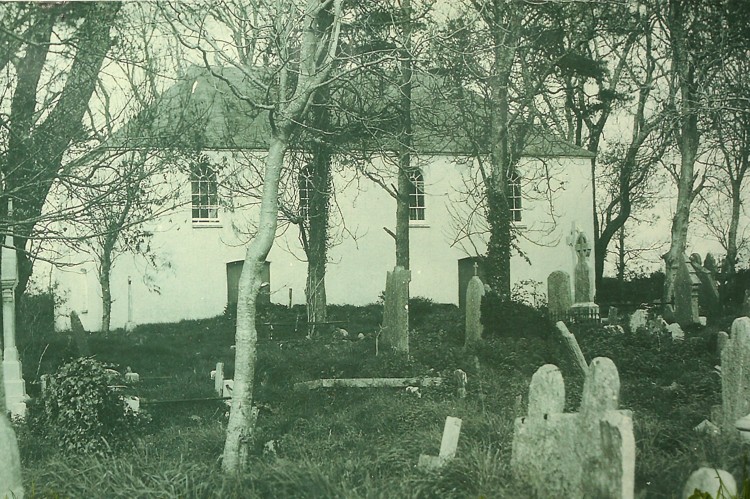Let us journey back in time to one of the most unique, peaceful and historical Church and Graveyard in Ireland. Here we have an abundance of Heritage and History. One cannot have Heritage without History, or History without Heritage. Many people would like to skip some chapters in our Irish history book, but history is history, is history which cannot be obliterated or rewrote and the book cannot be closed until each and every chapter is read, regardless of one’s own opinion.
Kilbrogan parish, known by its old name Kill-og-in-eg was recorded in history four hundred years before Bandon was founded. The Catholic Church and lands at Kill-og-in-eg were rated at six silver marks a year by order of Pope Nicolas IV in the year 1291 AD. The Church was dedicated to Saint Michael the Archangel and stood upon the site of the present ruins of Kilbrogan Church. Previous to the Reformation, the right of presentation to the Parish of Kilbrogan lay in the hands of the Monks of Mourneabbey.
The Church was totally demolished by the colonists in 1610 to afford building material for the Protestant Church of the Holy Trinity, better known as Christ Church, (now the West Cork Heritage Centre & the burial place of Sean Dearg Nash) which was erected in North Main Street.
The Churches previously devoted to the Catholic religion had been taken from the Roman Catholics at the time of the English Reformation; and some of these perform Protestant duty to the present day, for example, the Church of Saint Multose Kinsale, Saint Finbarr’s in Cork, the parish Churches of Youghal, Lismore and many others.
If walls had ears, we may fairly assume that the stones in the first Protestant Church in Ireland, built by the stones from the Catholic Church in Kilbrogan have been listening to both sides of the question for centuries.
After a lapse of approximately 186 years, which included the era of the Mass rock, the priests on the run and a bounty of ten pounds offered for the apprehension of any Jesuit or Bishop, Father Shinnick got Kilbrogan Church (CO096-064001-) re-built in 1796. Two years later the Church was burned by Scottish soldiers during the 1798 rebellion but the gallant Father Shinnick again came to the rescue and had it restored to its former glory.
Most Rev. Dr. Delaney, Bishop of Cork was born in the Sacristy attached to the Church on Christmas day 1804. His father, a weaver by trade, and his mother a member of the Quinlan family, lived just beyond Kilbrogan Street, near the well, which is still known to locals, as the Bishops Well.
Bishop Delaney was ordained at the age of 24 and having spent some time as a curate in Cork city, he was appointed Parish Priest of Bandon in 1845. Two years later as the famine stalked the land; he was made Bishop of Cork and ruled the Diocese for 39 years. He died on the 14th November 1886 and was interred in the Cemetery at the Ursuline Convent, Blackrock, Cork.
The Church holds some treasured memories which are sacred, especially to the past generations of Kilbrogan and to the people of its immediate surroundings. Every Sunday morning people flocked there to partake at 9.30 am Mass which was officiated by the Convent chaplain. Some of the chaplains who officiated there were Father Murphy, Father Twohill and Father Barrett, who was there in 1910.
The caretaker of the Church during these times was Mike Cotter. Each Sunday morning, Mike brought the priests vestments in a basket, along with a little red jug bearing fresh water for the priest.
These were the days when there was no means of transport apart from the horse and cart, or the horse and trap. The majority of the people always walked to Mass and many came across the fields from Kilbrogan, Cork Road, Kilpatrick, Castlelack, Ballinacurra, Kilmore, Fennis, Curriclough and Mishells. The priest always walked from the Convent but after Mass he got a drive back by horse and trap from the Cahill’s of Curriclough.
The Sunday morning scene at Kilbrogan was always the same routine. The first one to arrive was Jack Forde who was the collector at the door. The usual donation at that time was a half-penny. There were 480 half-pennies in the pound at that time. The horses and traps which brought the senior citizens were always a familiar sight outside the graveyard wall on Sunday mornings.
A battalion of about eight or ten foot soldiers marched from their barracks at Kilbrogan Hill to Mass each Sunday. Their barrack was where Scannell’s supermarket is now on Kilbrogan Hill. Other dignitaries to attend Mass there were Doctor Neville and his family and PJ McCarthy, then solicitor in Bandon.
Some of the altar boys remembered are, Nicholas Butler, O’ Mahony Avenue : Jim O Mahony, Convent Hill : John Phelan, Kilbrogan Street and brothers Chris, Joe and Con Byrne, Convent Hill. Con Byrne was the last altar-boy to assist at mass before the closure of the Church in 1923.
On entering the Church, the altar was in the centre of the northern wall facing south. Adjoining it on the western side was the Vestry. The altar was dressed and kept in flowers by some of the local ladies.
There were three rows of galleries serviced by two stairs. There is a buttressed wall to the back of the Church due to a split in the gable end.
Kilbrogan Church remained in constant use until 1923, when it was abandoned in the pretence that the roof was damaged by storm and that the walls were in a dangerous condition.
The Architectural Heritage book of West Cork was launched on Friday 17th June 2011, at the County Hall Cork. It was wonderful to see that Kilbrogan Church and Graveyard was illustrated within the booklet showcasing the highlights of the National Inventory in the West Cork area.
John Desmond.




